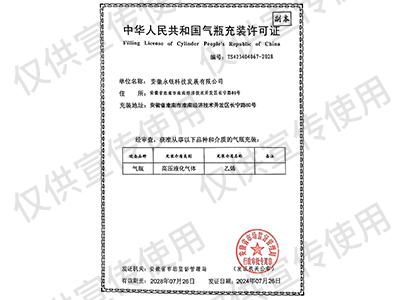Knowledge of gases
What are the applications of ethylene in the industrial field?
1、 Plastic industry: producing various polymer materials
Ethylene is the main raw material for synthesizing plastics, and various commonly used plastics are produced through polymerization reactions
Polyethylene (PE):
Ethylene is polymerized to produce polyethylene, which is the most widely produced plastic variety in the world. According to different densities and structures, it can be divided into:
Low density polyethylene (LDPE): With good flexibility, it is used to make films (such as food packaging film, agricultural film), hoses, etc;
High density polyethylene (HDPE): With high hardness and strength, it is used to make plastic bottles (such as beverage bottles, detergent bottles), pipes, plastic buckets, etc;
Linear low-density polyethylene (LLDPE): It combines toughness and strength, and is mainly used for packaging films, garbage bags, etc.
Other copolymer plastics:
Ethylene can be copolymerized with monomers such as propylene and vinyl chloride to produce ethylene propylene copolymers (used for modified plastics), ethylene vinyl chloride copolymers (EVC, used for pipes, films), etc.
2、 Synthetic fiber industry: manufacturing fibers such as polyester
Polyester (Polyethylene terephthalate, PET):
Ethylene is oxidized to produce ethylene glycol (derived from EO), which reacts with terephthalic acid to produce PET, which is then spun into polyester fibers. Polyester is one of the most commonly used synthetic fibers, widely used in clothing, home textiles (such as curtains, bedding), industrial filter cloth, tire cord, etc.
3、 Synthetic rubber industry: producing elastic materials
Ethylene propylene rubber (EPR/EPDM):
Ethylene and propylene (sometimes with a small amount of non conjugated diene) are copolymerized to produce ethylene propylene rubber, which has excellent weather resistance, ozone resistance, and heat resistance. It is used in automotive tires (inner tubes, seals), building waterproofing materials, wire and cable insulation layers, etc.
Auxiliary raw materials such as styrene butadiene rubber:
Ethylene can be used as a raw material to produce butadiene (through cracking process), which can then be used to synthesize styrene butadiene rubber, butadiene rubber, etc. for tires and rubber products.
4、 Chemical intermediates: preparation of various organic chemicals
Ethylene undergoes reactions such as oxidation, chlorination, and hydration to generate a series of important chemical intermediates, which are further processed into downstream products
Ethylene oxide (EO):
Ethylene is catalyzed by silver to produce ethylene oxide, which is an important chemical raw material
Hydrolysis to generate ethylene glycol (used for PET synthesis and antifreeze);
Reaction with alcohol to produce polyether (used for surfactant and polyurethane foam);
Derived from ethanolamine (used in detergents, gas purification), etc.
Vinyl chloride (VCM):
Ethylene is chlorinated to produce dichloroethane, which is then cracked to obtain vinyl chloride, a monomer used in the production of polyvinyl chloride (PVC). PVC is used for pipes, boards, doors and windows, toys, etc.
Styrene:
Ethylene and benzene undergo alkylation reaction to produce ethylbenzene, which is then dehydrogenated to obtain styrene, which is used for the synthesis of polystyrene (PS, packaging materials, toys), ABS resin (household appliance shells, automotive parts), etc.
Acetaldehyde and Acetic Acid:
Ethylene can be oxidized to produce acetaldehyde, which is further oxidized to obtain acetic acid (acetic acid), which is used in pharmaceuticals, food additives, solvents, and other fields.
Ethylbenzene, ethylbenzene, etc.:
Used for the production of spices, dyes, pharmaceutical intermediates, etc.
5、 Other industrial applications
In the field of agriculture:
Ethylene is a natural plant hormone that can be industrially synthesized into ethephon (a compound that releases ethylene), which is used to promote fruit ripening (such as banana and tomato ripening), promote crop flowering or leaf shedding, and so on.
Fuel and Energy:
Ethylene can be used as fuel gas (such as mixed with other hydrocarbons as industrial fuel), but due to its high value, it is usually preferred for chemical synthesis.
Welding and cutting:
Ethylene mixed with oxygen can form a high-temperature flame, which is used for welding or cutting metals (but not as widely used as acetylene).
summarize
The application of ethylene runs through the entire industry chain from basic chemical raw materials to end consumer goods, and its production and consumption are often regarded as important indicators of a country's petrochemical industry development level. With the development of new material technology, the downstream applications of ethylene are constantly expanding, such as innovation in high-performance polyethylene (such as ultra-high molecular weight polyethylene, used for bulletproof materials, medical devices) and other fields, further consolidating its core position in industry.





